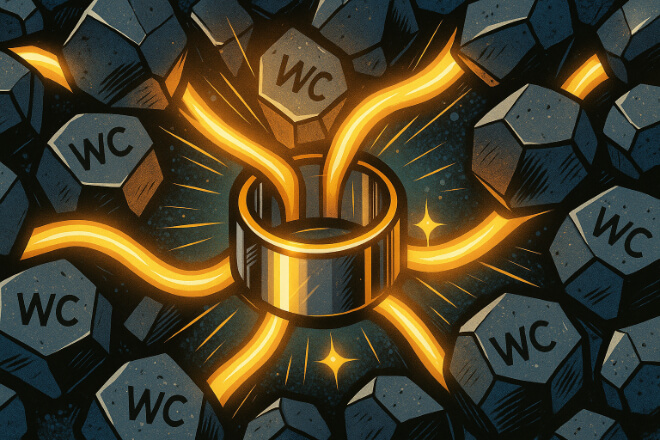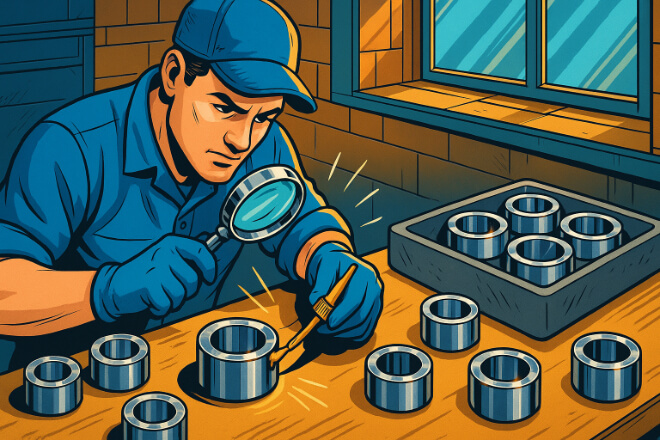bagues en carbure de tungstène are essential components in many industrial systems, valued for their dureté, résistance à l'usure, et la durabilité.
The performance of these bushings depends not only on the tungsten carbide (WC) itself but also on the type of metal binder used—most commonly nickel (Ni) or cobalt (Co).
The binder holds tungsten carbide grains together, influencing properties such as toughness, résistance à la corrosion, and thermal stability.
Choosing between nickel-bonded and cobalt-bonded bushings can significantly impact the service life and performance of machinery.
This article explains the key differences between the two types and offers guidance on selecting the right one for your application.
Understanding the Role of Metal Binders in Tungsten Carbide

Tungsten carbide by itself is extremely hard but also brittle. To make it usable in engineering applications, metal binders are added to form a composite.
The binder provides ductility and toughness while maintaining hardness.
Functions of the Binder:
Holds WC grains together for mechanical strength.
Improves dureté to prevent cracking under load.
Influences résistance à la corrosion, depending on the binder type.
Affects thermal stability, making one type more suitable for specific environments.
The two most common binders—nickel and cobalt—offer distinct advantages and limitations, which we’ll explore next.
Composition and Properties of Nickel-Bonded vs. Cobalt-Bonded Tungsten Carbide
Nickel and cobalt have different metallurgical behaviors, which directly influence the properties of tungsten carbide bushings.
The table below compares the two types:
| Propriété | Nickel-Bonded Tungsten Carbide | Cobalt-Bonded Tungsten Carbide |
|---|---|---|
| Résistance à la corrosion | Excellent — suitable for chemical, oil & gas, and marine environments | Moderate — can corrode in acidic or chloride-rich conditions |
| Dureté | Slightly lower toughness than cobalt | Higher toughness, better shock resistance |
| Résistance à l'usure | High wear resistance in corrosive environments | Very high wear resistance under dry or lubricated conditions |
| Temperature Stability | Stable up to 500°C | Stable up to 700°C |
| Magnetic Properties | Non-magnetic | Magnetic |
Advantages of Nickel-Bonded Tungsten Carbide Bushings

Nickel-bonded bushings are popular for applications that require excellent corrosion resistance and chemical stability.
1). Key Benefits:
Supérieur Résistance à la corrosion: Nickel resists oxidation and chemical attack, making it ideal for pumps and compressors in chemical plants, marine, or pétrole et gaz industries.
Non-Magnetic Nature: Suitable for use in electronic and precision instruments where magnetism must be avoided.
Smooth Surface Finish: Nickel’s fine grain structure allows a highly polished surface, which helps reduce friction and improve sealing.
2). Ideal Applications:
Chemical processing equipment
Subsea and marine pumps
Semiconductor fluid systems
Chemical injection pumps
Nickel-bonded bushings are slightly more expensive but deliver a longer service life in corrosive or wet environments.
Advantages of Cobalt-Bonded Tungsten Carbide Bushings

Cobalt-bonded bushings are the traditional and most widely used type due to their excellent mechanical toughness and wear resistance.
1). Key Benefits:
Supérieur Dureté: Cobalt enhances shock absorption and prevents brittle fracture under impact or vibration.
Higher Temperature Resistance: Can operate effectively at higher temperatures compared to nickel-bonded bushings.
Excellent Résistance à l'usure: Performs exceptionally well in abrasive or high-speed applications.
2). Ideal Applications:
Industrial compressors and turbines
Machine tool spindles
Mining and drilling tools
High-speed pump systems
Cobalt-bonded bushings are the best choice where toughness and wear resistance are more critical than corrosion resistance.
Choosing the Right Binder for Your Application
The choice between nickel and cobalt binders depends on the operating environment and performance priorities.
Selection Guidelines:
| Condition | Recommended Binder | Raison |
|---|---|---|
| Corrosive or chemical environment | Nickel | Resists oxidation and acid corrosion |
| High impact or mechanical shock | Cobalt | Provides better toughness and shock absorption |
| High-temperature operation | Cobalt | Withstands up to 700°C |
| Magnetic-sensitive equipment | Nickel | Non-magnetic properties |
| Precision seals and smooth finishes | Nickel | Allows fine polishing and lower friction |
When in doubt, consult the manufacturer or conduct a material compatibility test under actual operating conditions.
Maintenance and Handling Tips for Both Types

Regardless of the binder type, proper care ensures optimal performance and longer lifespan for tungsten carbide bushings.
Best Practices:
Avoid Impact: Tungsten carbide is brittle; handle with care to prevent cracks or chips.
Proper Lubrication: Maintain consistent lubrication to reduce wear and prevent overheating.
Monitor Corrosion: Even nickel-bonded bushings can degrade under extreme chemicals—inspect regularly.
Temperature Control: Avoid sudden temperature changes that may cause thermal shock.
Clean Regularly: Remove abrasive particles that can cause surface wear.
Conclusion
Both nickel-bonded and cobalt-bonded tungsten carbide bushings offer exceptional strength and performance, but they excel under different conditions.
Nickel-bonded bushings are the best choice for corrosive, chemical, or non-magnetic environments, while cobalt-bonded bushings perform better in high-load and high-temperature applications.
Understanding the differences helps decision-makers choose the right material for maximum efficiency, reliability, and cost savings.
Si vous souhaitez en savoir plus sur une entreprise, n'hésitez pas à Contactez-nous.
